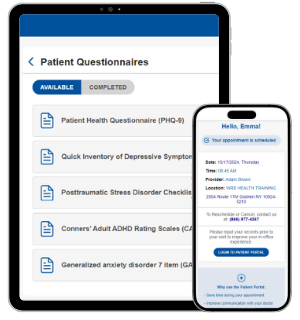Key Takeaways
- AI reduces patient frustration through behind-the-scenes support.
- Automation improves communication, access, and personalization.
- AI shows how to increase patient satisfaction in healthcare while reducing staff burden.
- Prepare for a successful transition to smarter tech your patients will love.
From long wait times to confusing billing, there are plenty of reasons patients walk away from healthcare encounters feeling frustrated. And even more concerning, they don’t often complain, leaving providers unaware and health outcomes at risk.
But what if technology could fix that? Not in a disconnected, robotic way—but in a quiet, behind-the-scenes way that improves what patients feel, even if they don’t notice exactly how.
It’s a clear example of how to increase patient satisfaction in smarter, more efficient ways using AI.
AI in healthcare is becoming a vital tool for improving patient satisfaction, and it reaches far beyond diagnostics and chatbots. And in value-based care environments, where experience matters just as much as outcomes, it’s more than a nice-to-have—it’s essential.
Table of Contents
What Do Patients Actually Want?
Let’s start with the basics. When patients talk about a good healthcare experience, they usually mean:
- Being heard and understood
- Easy scheduling and minimal wait times
- Getting clear information about their care and costs
- Feeling like their provider knows them
In short, they want communication, convenience, and personalization. That’s a tall order for busy providers—but it’s the sweet spot for AI tools designed to support better patient satisfaction.
Faster, Friendlier Scheduling and Intake
Have you ever spent 20 minutes on hold just to book an appointment? Patients have, and they don’t like it.
AI tools can streamline front-office tasks like appointment scheduling, patient registration, and digital intake. Automated systems can handle routine requests 24/7—no need to wait for office hours or tie up staff. But the real benefit is this: patients get a smoother, faster experience, and front-desk teams get more time to help people who actually need human attention.
Bonus: AI-based scheduling can also reduce no-shows by sending smart appointment reminders based on patient preferences (text, email, etc.).
Personalized, Human-Centered Communication
Patients are often unclear on what to do next. Busy schedules can lead to missed communication, and complex instructions are easy to overlook.
AI helps close the gap. Machine learning models can analyze patient history and preferences to send personalized follow-up instructions, reminders, or education. If someone has a new prescription, for example, the system can automatically share tips about side effects or proper usage.
This doesn’t mean your patients receive generic auto-emails—they’re targeted, timely messages that keep patients informed without overwhelming staff. It’s communication that feels personal, even when it’s automated.
And for patients with chronic conditions or complex treatment plans, AI can help care teams prioritize outreach, so no one misses key interventions.
Smart Documentation Can Foster Connection
If you’re looking at how to increase patient satisfaction, one of the most powerful (and often overlooked) ways is by using AI to ease the documentation burden.
Physicians spend up to half their day on EHRs and notes, which leaves less time for eye contact, listening, and building rapport. Ambient AI and smart dictation tools are changing that.
These systems “listen” to visits in real-time and automatically create structured, accurate clinical notes—saving time and freeing providers to focus on the person in front of them. The result? More meaningful conversations, more trust, and better understanding—all key ingredients for patient satisfaction.
Set your practice up for success with smart tools from WRS Health
Supporting Value-Based Care Goals
Value-based care models show how to increase patient satisfaction in healthcare—when done right. While experience ratings may seem like a soft metric, they directly impact how organizations are paid and evaluated. AI helps practices meet these goals without adding extra strain on staff.
From identifying gaps in care to optimizing outreach for preventative screenings, AI allows teams to be more proactive. That means patients get more consistent, coordinated care, which translates to better outcomes and a better experience.
It also supports accurate risk stratification, ensuring high-risk patients receive the attention they need—often before they even ask for it.
Reducing Friction at Every Step
Think about the moments that frustrate patients most. It’s rarely the clinical care—it’s “everything else”:
- Waiting too long for lab results
- Being transferred between departments
- Not understanding a bill
AI can’t solve all of these instantly, but it can reduce friction.
For example, predictive analytics can flag delays before they happen, so staff can communicate proactively. Natural language processing (NLP) can help generate clearer patient visit summaries at a middle-school reading level. And intelligent billing systems can spot coding errors or flag confusing language before a statement goes out.
These small touches—powered by AI but guided by real patient needs—add up to a big impact on how patients feel about their care.
AI That Feels Human
At the end of the day, how to increase patient satisfaction in healthcare using AI isn’t about replacing the human touch—it’s about supporting it.
AI gives healthcare teams time, insight, and tools to deliver better experiences with less burnout. It helps patients feel seen, heard, and cared for, even in a fast-paced healthcare office.
And while patients might not notice the tech behind the scenes, they’ll notice how their care feels: smoother, friendlier, and more personal.
That’s the real win.






 QUICK CHARTING
QUICK CHARTING NOTE
NOTE MEDICATION
MEDICATION PATIENT
PATIENT BILLING
BILLING RISK
RISK MARKETING
MARKETING MIPS
MIPS